The last month has shown there’s some serious problems with the Sydney Roosters this season. Sandwiched between a two losses to Penrith with combined scores of 78-10 were a two point loss to the Dragons and a one point win over the Bulldogs.
The club’s issues scoring have been well noted this season. Trent Robinson mentioned in his post-game press conference after Saturday’s embarrassing loss to Penrith that he’s aware of it and it’s something he needs to work on.
“We are not scoring enough tries and we are not even pressuring teams enough at the end of sets. We are not getting held up. We are not getting repeat sets. We are not getting any of that at the moment.
“It is difficult to apply pressure and that puts pressure on your defence. Our defence should have held up for longer periods than it did and we didn’t.”
What is the cause of the Roosters slump this season? Is it just the number of errors they commit?
The answer is yes, and also no.
Usually I’d start off looking at margins and scoring when I start my team deep dives. However this week, to get the elephant in the room out of the way first, the errors are definitely a big part of their lackluster play. But not the only part and we’ll get to that eventually.
Below is the error rate (number of possessions needed on average to generate an error) for the 2023 season up until Sunday night Round 15, sourced from Fox Sports Stats as usual.

And it should be very clear here that errors are the main issue, but not the only one and we’ll get to that soon. The Roosters have their lowest error rate in a number of seasons at one every 33 touches. That number is dead last in the NRL this season, three possessions lower than 16th placed Cronulla at 36.1.
It’s not so much the error rate itself but the fact they’re last in the league. Their error rate has been mid table recently – the last three seasons they’ve been 8th, 11th and 11th. This year it’s plummeted and Saturday evenings game was a great example. Those with a keen eye will also note their number of possessions per game, and we’re going to get to that shortly.
Here’s the Roosters historical error rate as well, showing that this season, whilst being poor, is actually in line with their mid to late 2010’s error rate.

That 33.89 is still higher than their title winning seasons in 2018/19. The difference is they were never dead last in error rate. Yes they were usually bottom half in the competition, or sometimes second last, but never last.
And If you look at individual error rate, it’s a very bleak picture.
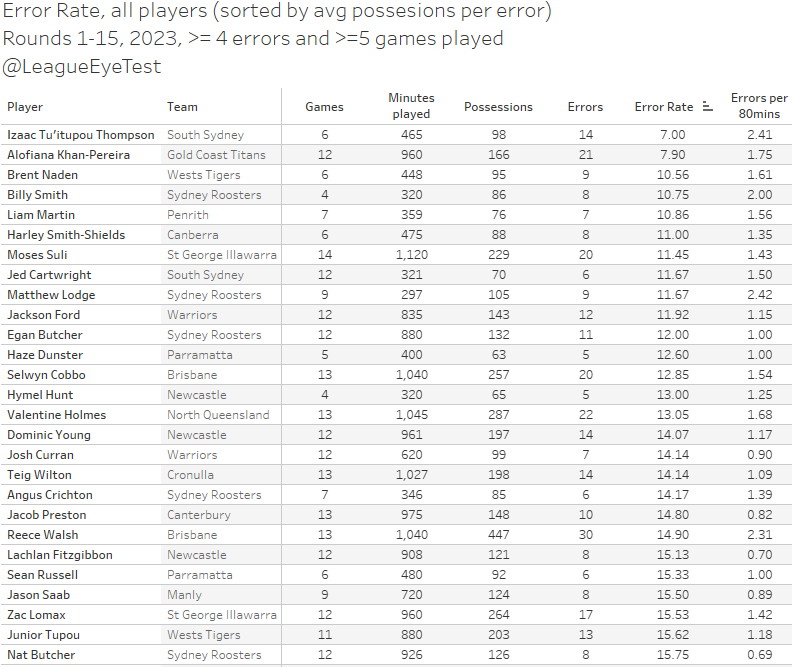
There are 56 NRL players with at least 4 games played have an error rate of one every 20 touches or fewer and seven of them are Roosters. No other team has more than five, and there’s usually not many middle forwards.
For the Roosters, Billy Smith is by far the worst of them with 8 mistakes in four games from 86 touches, or one every 10.75 possessions. No wonder he found himself out of the line up on Saturday, replaced by noted turnstile Drew Hutchison.
The others with a rate below 20 will be familiar names for the Roosters faithful – Matt Lodge, Egan Butcher, Angus Crichton, Nat Butcher, Sitili Tupouniua and Joseph Sua’ali’i. I’m sure Dominic Young coming in next season will fix this right up.
Roosters fans will be chiming in with “we know we can’t hold the ball, it’s been the case for the last decade”. Which is absolutely true, the Roosters under Robinson have always had a below average completion rate, but it didn’t affect their chances previously as much as it is now. Here’s their completion rates up to Round 15 since 2014.
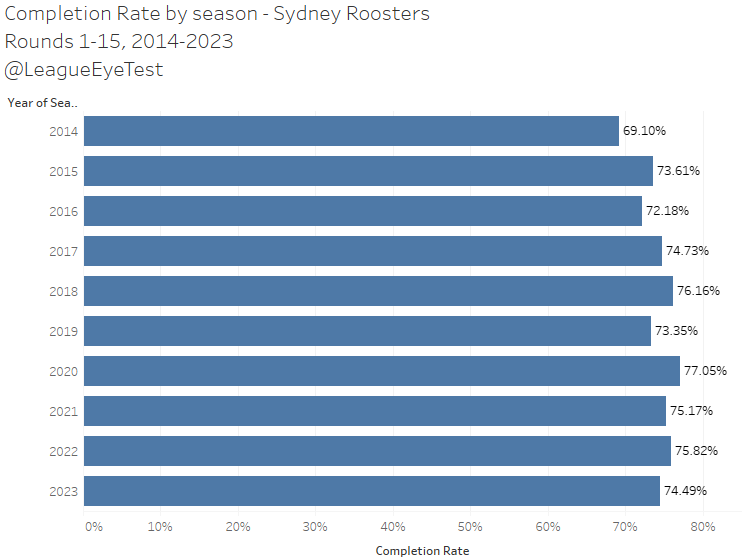
Nothing out of the ordinary here, and it’s actually on the higher end for the club since 2014.
As I’ve mentioned multiple times on this, completion rate is a useless statistic in a vacuum. Is a team completing 32/39 sets (82%) doing better than one completing 35/43 (81%)? The second team has had three more complete sets but only one more incomplete set. The percentage is meaningless in isolation.
Back to the Roosters and the reason why a low completion rate worked for them historically. The main reason is that they were keen to throw the ball and chance their arm, and more often than not it paid off thanks to the quality of players in their 17. If you don’t take a chance, you miss out on the possibly reaping the reward. Throw enough risky passes and a few may pay off, and if they don’t then bank on your defines to hold on until you get another chance.
And this is why the error rate this season is more alarming. It’s come from a game plan that statistically looks very conservative compared to prior seasons under Robinson.
What do I mean by conservative? To set the scene, the Roosters are averaging the same number of play the balls as they have in previous seasons at around 141 per game. This means the number of “chances” for them to do something with the ball is roughly the same, which means year on year comparisons are valid. Keep this in mind for later as well.
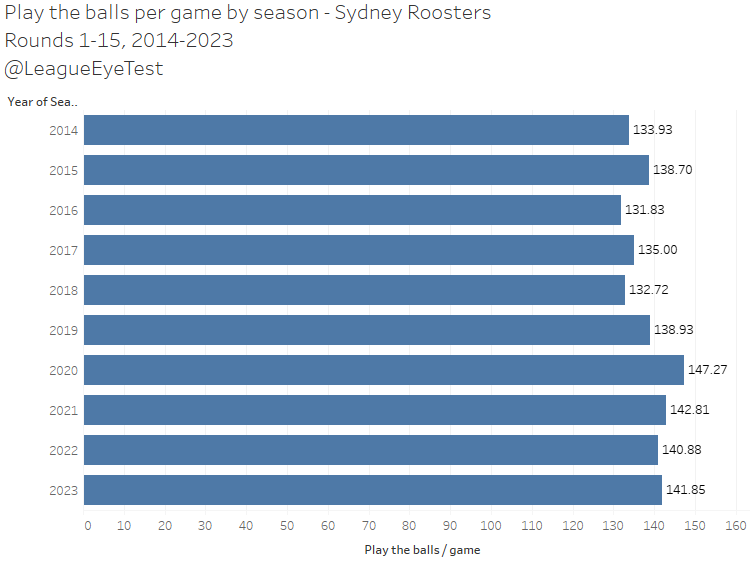
But knowing they have a similar number of play the balls, if you look at the year on year change for some attacking statistics there’s signs he’s becoming much more cautious.
The first one is simple – the number of general play passes per game is down almost 20 from last season and their lowest since 2014.

The haven’t averaged fewer than 97 since 2020, although some of that is due to the inflation from peak six again football. But as noted above it’s still lower than every season in the chart prior. This would indicate a less expansive game, and it looks like that when you check offloads as well. The Roosters are averaging just 7.54 per game this year, down over 2 offloads per match from last season and even more from a recent peak of 10 per match in 2020.
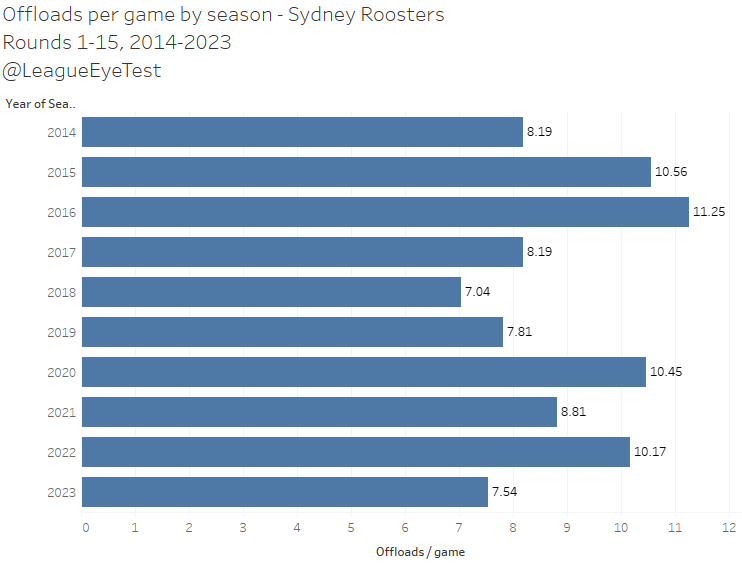
They’re also engaging the line less than prior seasons. In 2023 that number is just 31.7 per game, down from 36.9 in 2022, and 36.4 in 2021. So not only are they passing the ball less, when they do run the ball, they’re not engaging the line when they do so.
Need some more evidence? One pass runs, your standard one out hit up, are up from 41.2% to 47.4% of all runs, an increase of over 5%. They’re still running the same volume of people in motion with the ball. The percentage of option runs (decoy or support) from all runs is very similar year on year, at 34.1% in 2023 and 32.55% twelve months ago.
In the end it’s not resulting in better quality outcomes though. Their percentage of runs over 8 metres is just 58%, down from an average of over 62% for the past three seasons. What good is being safer with the ball if you’re not benefiting from it?
This is also evidenced in their metres per run, which is just 8.56 his season, a drop of half a metre per run from 9.07 last year. That number is 4th worst in the NRL, as seen below.
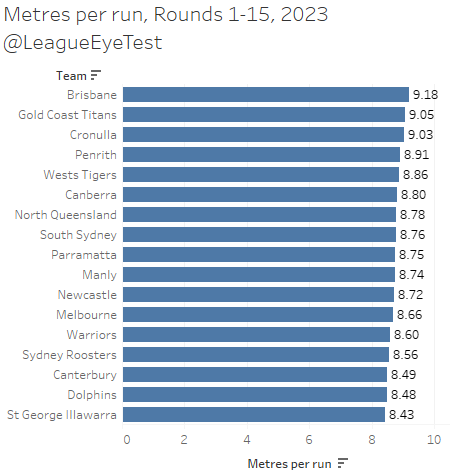
And it’s the lowest for the Roosters since 2014, and the first time they haven’t approached or bettered nine metres per run.

We’ll get into this number a bit more later as well. But when you’re only outrunning the Dolphins, Dogs and Dragons there’s an issue. The 9.07 mentioned above placed them 5th in 2022 and they’ve not had a season lower than that since 2014. Until now that is.
Interestingly the Roosters don’t allow many metres per carry, ranking equal third best in the NRL at just 8.4m per run.

It’s a unique set of numbers. They’re seeing a similar play the balls but creating more errors. The number of sets has dropped but the number of tackles per set has increased as they’re playing safety first. This is coming even with fewer passes, fewer offloads, and more one out runs.
In the end it appears to have just neutered their attack. Metres per run are down as is the number of long runs. If you’re trying to limit errors, but not getting as far downfield, is that the right answer? And if this is what limiting errors looks like, I’d hate to see how badly they handle the ball with more risks.
The drama around their halves is obviously playing a part. Sam Walkers future at the club looks tenuous. As a Five Eight, Joey Manu makes a very good centre and probably an even better fullback. Luke Keary can’t do everything himself and their end of set options are lacking. Even getting a clearing kick away is becoming a struggle.
You can see this when you look at the average metres downfield for the first play the ball per opponent this season. The Roosters are equal fourth worst with their foes starting 39.2 metres out.

Now, to get an idea of an average set starting point and not have attacking sets skew the results, let’s take out any tackle 1 play the balls starting inside 20 metres.
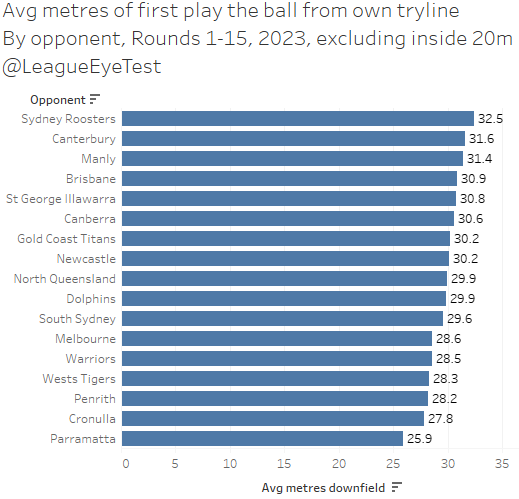
The Roosters are now the worst team in the competition, letting opponents start 32.5 metres out, almost one metre higher than the Bulldogs. Another sign that their long kicking game and subsequent chase isn’t up to scratch. Notice the teams with strong long kicking games like Penrith and Parramatta are having opponents start closer to their own goal line.
There’s also the issue that James Tedesco’s form. When he’s on he’s still one of the best fullbacks in the game. But usually as father time starts to take over, players can still hit their peaks just not as often.
If you look at Tedesco’s Eye Test Player Contribution Rating, which is the site’s possession adjusted player attribution metric, he’s having his lowest season since 2017.

That +0.97 points per possession normalised game is still a good number, but not at the level of his prior seasons. The rating is based on accruing statistics that contribute to winning, like tries, try assists, run metres. With the Roosters scoring fewer points this season, that number is actually more impressive than it looks.
Part of the issues getting downfield stems from the makeup of their forward pack. Besides Lindsay Collins and Jared Warea-Hargreaves, the only other Roosters above the 51st percentile for metres per game from forwards is Lodge. Collins is having a tremendous season but has diminished returns once his minutes creep over 50. And the other two are only averaging 41 and 33 minutes per game respectively, and both have their own unique flaws that limit their positive contributions.
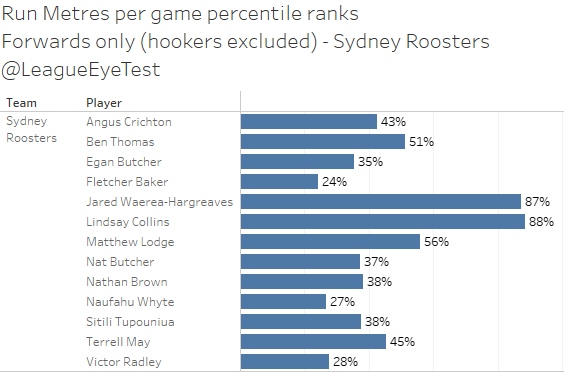
There’s no big minute metre eating forward at the club that can be relied upon to get them out of a hole. Nat and Egan butcher are the only forwards above the 66th percentile in minutes played, and the only other statistic they’re above the 50th percentile for is tackles completed.
Again, this isn’t a huge departure for Robinson coached sides, as they’ve always valued high impact bench players. This may be why the club targeted Spencer Leniu, who has consistently posted high volume running numbers in short minutes.
Remember that metre per run breakdown from earlier? Only Naufahu Whyte is their only forward above the 77th percentile. Crichton for example, is in the 7th percentile, meaning 93% of NRL forwards average more metres per run than him.
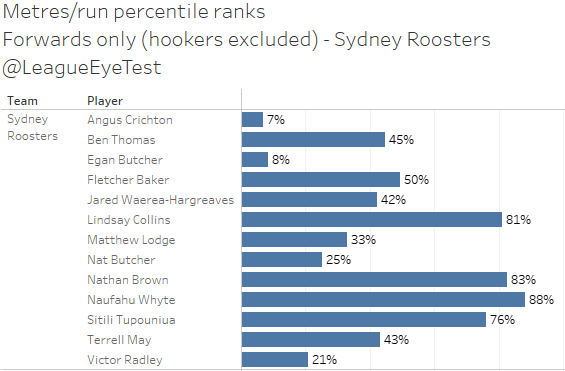
And for all the talk of Victor Radley helping out, other than tackles (and I guess sin bins?), he’s below the 37th percentile in almost every other major forward statistic.
Another problem for the Roosters this year is handing over possession early in games and giving up a lead.
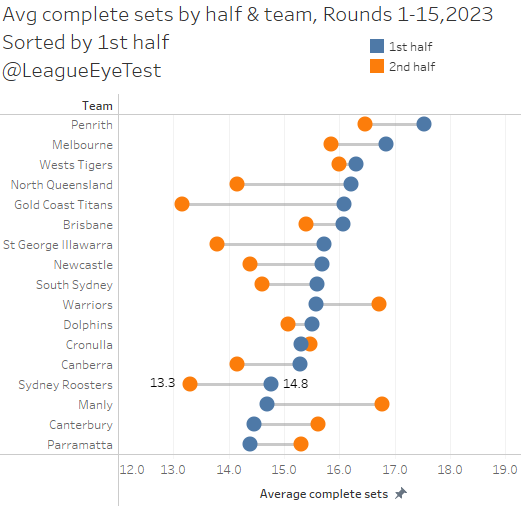
The Roosters have the 4th lowest average for complete sets in first halves (14.8), and are 16th for second halves (13.3). Their opponents are 2nd in the NRL for average number of complete sets in the first half as well at 16.8.

Obviously with the volume of errors the Roosters are making, it’s hard to be winning when you’re allowing your opponents’ two complete sets more in the first half.
Compounding error issues in the first half is their discipline, with the club giving away more penalties per set than any club other than the Bulldogs inside the first 40 minutes, at nearly one every 5 sets (0.19 per set).

Given these problems, it’s no wonder that their average margin by minute looks terrible for 2023. Surprisingly they’re getting on the board early in most games, but once the errors and penalties start to flow the damn bursts and there’s not enough fingers to plug all of the holes.
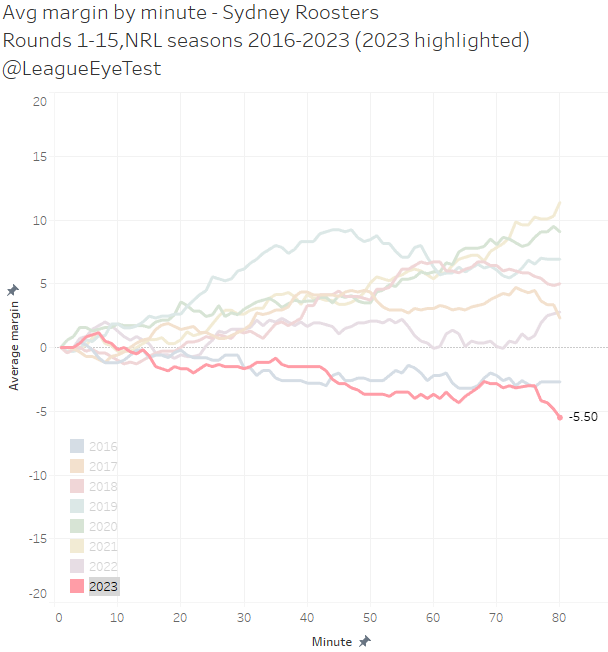
From the 10th minute on their average margin turns negative and after the 14th minute doesn’t get close again. It ends up as the worst average margin up to Round 15 since 2016 for the team and one of just two seasons with a negative margin after 80 minutes up to this point in the season.
They’re also switching off in the final five minutes of games this season, where the average margin nearly doubles form -3 to -5.5 after the 75th minute. I never thought I’d see the day when I’d question the commitment of a Trent Robinson coached team but here we are.
Their edge defence has also been an issue, and if you look at their heat map for opponent play the balls, they’re one of the few teams to see not only a high intensity area in front of the posts, but also on both edges a few metres out.

It’s unusual to see a higher intensity close to the line in those red squares without a much higher intensity between the sticks. Teams obviously know where to target the Chooks and are setting up attacking raides on either edge.
And if you look at the Roosters own play the ball heat map you don’t see the same high intensity between the sticks.
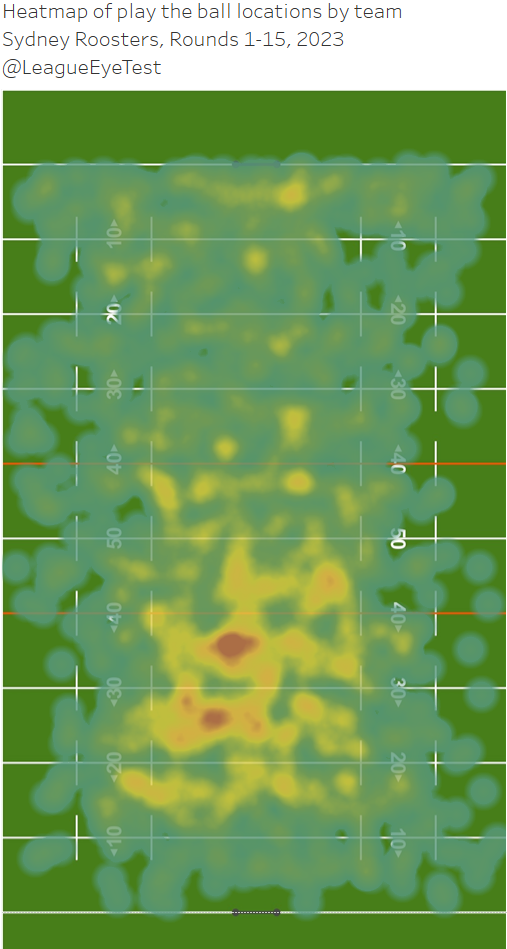
The higher volume of play the balls are occurring in their own half. Which probably indicates why they’re not troubling the scorers.This is evident when you plot their expected scores against actuals and not just looking at the percentages.

For actual points scored against expected points accrued they’re firmly in the “incompetent” quadrant, not too far away from the Canterbury Bulldogs. They’re not only not scoring, but they’re not using the ball in high point value areas. The Roosters are scoring just 16.1 points per game, second lowest in the NRL and their field position is worth 17.2 points per game, by far the lowest in the NRL.
Looking at points conceded versus expected points yielded, it’s not much better.

They’re again in the “incompetent” quadrant with the Knights, Titans, Raiders, Bulldogs and Cowboys, with their expected points conceded of 20.9 per game being 4th worst in the NRL. Despite giving up some monster scores to the Panthers, they’re still only midfield for points conceded at just 23 per game.
When you compare their actual scores to expected scores, they’re -6.1% below expected this year which is third worst in the league. This indicates that they’re not able to make the most of high point value possession when they do have it, which as we noted above is not very often.

Defensively it’s not a completely terrible situation, as being 10% over expected is in the top half of the competition and below the league average of 16%.
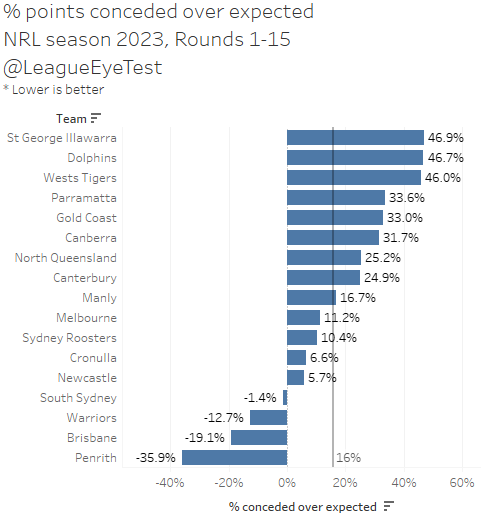
It’s a strange situation the Roosters find themselves in and it’s not one they can simply buy their way out of. Their current squad consists of some of the best players in the game, paired with some incredibly talented, but also incredibly flawed players.
Their style of play no longer works with the less than optimal seventeen they’re playing. They can’t score, can’t hold the ball, can’t stop conceding early penalties, their forwards can’t push the ball downfield, struggle to finish sets and they allow teams to start their sets too far downfield. And they’re doing this all of this in a less expansive and more conservative style than usual.
The numbers surrounding errors especially, and to a lesser extent discipline are deeply concerning, and the lack of punch from their forward pack isn’t something that can be fixed overnight. When you’re looking to Nathan Brown as a last hope you know there’s an issue. There’s no Sio Siua Taukeiaho or even an peak Isaac Lui walking through that door.
Robinson has shown the ability to get the best out of players previously, but his critics will usually counter with the fact that it’s not hard to get the best out of the best. With a less talented playing list than he’s had in years the Roosters look to be playing a more conservative brand of football and unsurprisingly it’s not paying off. Of course we can’t prove a negative so it might actually be the best option given the limitations of his list.
This is one of the toughest tests he’s faced leading a team and unless he’s able to get his side to control their errors and unlock some more strike from his forward pack, it’s hard to see the Roosters playing football in September.

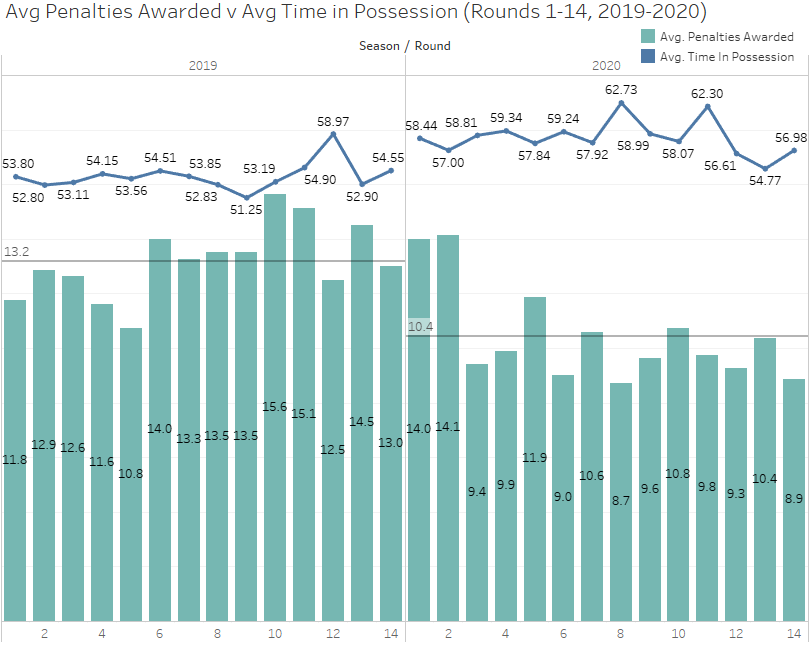
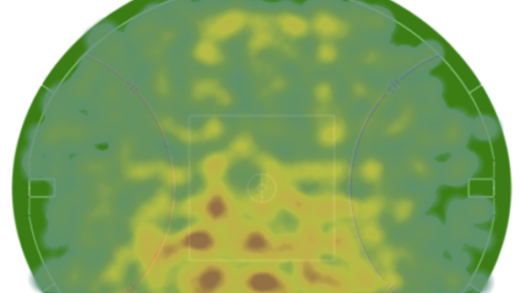
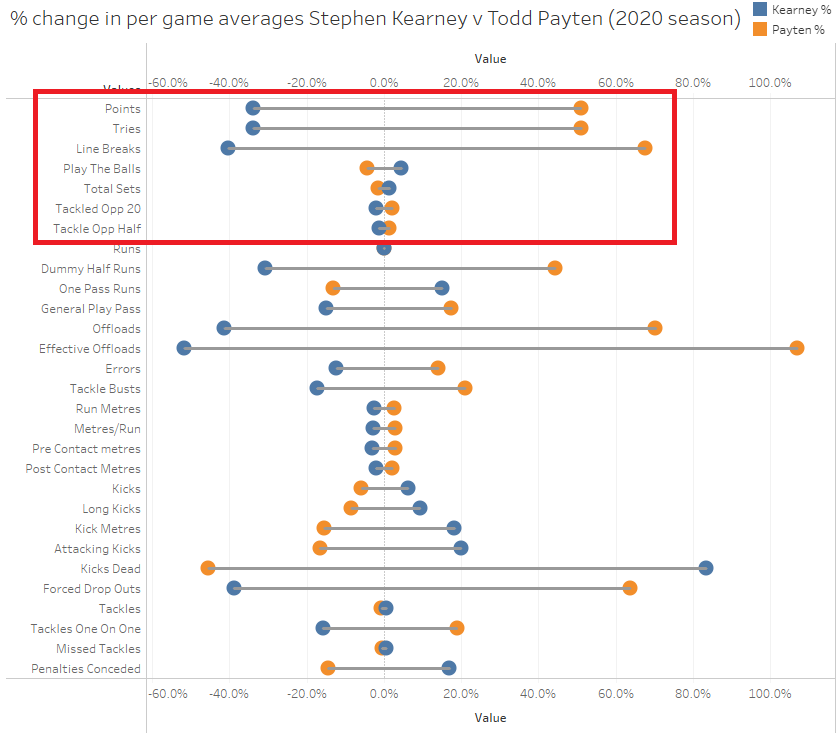
This is the greatest rugby league article I’ve ever read. Stats Porn. Just subscribed.